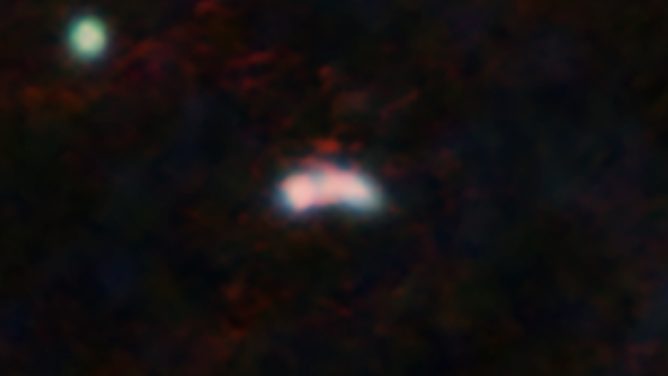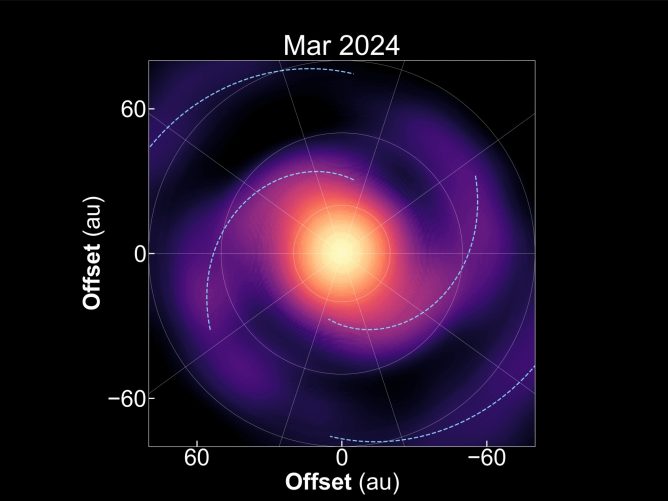Researchers using the Atacama Large Millimeter/submillimeter Array (ALMA) successfully imaged a radio “hole” around a galaxy cluster 4.8 billion light-years away from us. This is the highest resolution image ever taken of such a hole caused by the Sunyaev-Zel’dovich effect (SZ effect). The image proves ALMA’s high capability to investigate the distribution and temperature of gas around galaxy clusters through the SZ effect.

Image. The image shows the measurement of the SZ effect in the galaxy cluster RX J1347.5-1145 taken with ALMA (blue). The background image was taken by the Hubble Space Telescope. A “hole” caused by the SZ effect is seen in the ALMA observations.
Credit: ALMA (ESO/NAOJ/NRAO), Kitayama et al., NASA/ESA Hubble Space Telescope
A research team led by Tetsu Kitayama, a professor at Toho University, Japan, used ALMA to investigate the hot gas in a galaxy cluster. The hot gas is a key component to understand the nature and evolution of galaxy clusters. Even though the hot gas does not emit radio waves detectable with ALMA, the gas scatters the radio waves of the Cosmic Microwave Background and makes a “hole” around the galaxy cluster. This is the Sunyaev-Zel’dovich effect [1].
The team observed the galaxy cluster RX J1347.5-1145 located 4.8 billion light-years away. This galaxy cluster is well known among astronomers for its strong SZ effect and has been observed many times with radio telescopes. For example, the Nobeyama 45-m Radio Telescope, operated by the National Astronomical Observatory of Japan, has revealed an uneven distribution of the hot gas in this galaxy cluster, which was not seen in X-ray observations. To better understand the unevenness, astronomers need higher resolution observations. But relatively smooth and widely-distributed objects, such as the hot gas in galaxy clusters, are difficult to image with high-resolution radio interferometers.
To overcome this difficulty, ALMA utilized the Atacama Compact Array, also known as the Morita Array, the major Japanese contribution to the project. The Morita Array’s smaller diameter antennas and the close-packed antenna configuration provide a wider field of view. By using the data from the Morita Array, astronomers can precisely measure the radio waves from objects subtending a large angle on the sky.
With ALMA, the team obtained an SZ effect image of RX J1347.5-1145, with twice the resolution and ten times better sensitivity than previous observations. This is the first image of the SZ effect with ALMA. The ALMA SZ image is consistent with the previous observations and better illustrates the pressure distribution of hot gas. This image proves that ALMA is highly capable of observing the SZ effect and clearly shows that a gigantic collision is ongoing in this galaxy cluster.
“It was nearly 50 years ago that the SZ effect was proposed for the first time,” explains Kitayama. “The effect is pretty weak and it has been very difficult to image the effect with high resolution. Thanks to ALMA, this time we made a long-awaited breakthrough to pave a new path to probe the cosmic evolution.”
Note
[1] “Cosmic Microwave Background (CMB)” radio waves come from every direction. When CMB radio waves pass through the hot gas in a galaxy cluster, the radio waves interact with high-energy electrons in the hot gas and gain energy. As a result, the CMB radio waves shift to higher energy. Observing from the Earth, the CMB in the original energy range has less intensity near the galaxy cluster. This is called the “Sunyaev-Zel’dovich effect,” first proposed by Rashid Sunyaev and Yakov Zel’dovich in 1970.
These observation results were published as Kitayama et al. “The Sunyaev-Zel’dovich effect at 5″: RX J1347.5-1145 imaged by ALMA” in the Publications of the Astronomical Society of Japan in October 2016.
The research team members are:
Tetsu Kitayama (Toho University), Shutaro Ueda (Japan Aerospace Exploration Agency), Shigehisa Takakuwa (Kagoshima University / Academia Sinica Institute of Astronomy and Astrophysics), Takahiro Tsutsumi (U. S. National Radio Astronomy Observatory), Eiichiro Komatsu (Max-Planck Institute for Astrophysics / Kavli Institute for the Physics and Mathematics of the Universe, The University of Tokyo), Takuya Akahori (Kagoshima University), Daisuke Iono (National Astronomical Observatory of Japan / SOKENDAI), Takuma Izumi (The University of Tokyo), Ryohei Kawabe (National Astronomical Observatory of Japan / SOKENDAI / The University of Tokyo), Kotaro Kohno (The University of Tokyo), Hiroshi Matsuo (National Astronomical Observatory of Japan / SOKENDAI), Naomi Ota (Nara Women’s University), Yasushi Suto (The University of Tokyo), Motokazu Takizawa (Yamagata University), and Kohji Yoshikawa (University of Tsukuba)









